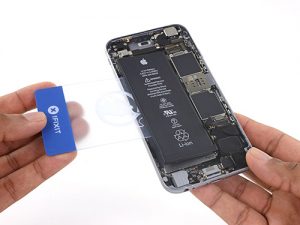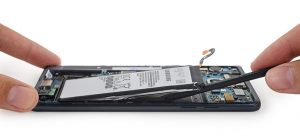
ifixit iPhone care
You are ready to spend a big sum of money on a new smartphone. And just like when you’re buying a new car, home, appliance, or TV, you’re presented with the option of getting device care protection.
With smartphones, there tends to be two main choices: protection provided by the smartphone manufacturer, and protection from the carrier. Which is best?

Samsung Note 7 battery repair
Smartphone Manufacturer Protection
The details vary depending on the manufacturer, but here we’ll look at the two biggest smartphone sellers: Apple and Samsung.
AppleCare+ is designed for iPhone owners, and its pricing varies based on the device you own. But it includes one-year of additional coverage beyond the standard one-year limited warranty, and is purchasable when you buy your phone, or up to two months after.
In addition to 90 days of support, 24/7 priority access to Apple experts, express replacement services, and software support,the coverage includes up to two incidents of accidental damage. But there are additional fees on top of the upfront fee: $39 for screen damage, or $129 for other types of damage, like water. But the coverage includes the battery and accessories like earphones as well, which is a plus.
Samsung Care+ provides protection for the company’s Android-based Galaxy devices. The walk-in service is available through more than 100 authorized partner stores across Canada, including Fonelab, Mobile Klinik, and uBreakiFix, so you don’t have to send your phone away. Rather, visit your nearest partner store should something go wrong and they can fix the phone for you, honouring your extra warranty coverage.
It covers things like physical and water damage for up to two years (so one year after the standard warranty) with the added advantage of being able to get your phone, in many cases, back the same day. It also guarantees that will you will get genuine Samsung parts, and that the company will use Samsung tools for the repairs.
Plans start at $170 for a tier-1 device, up to $210 for a tier-3, and cover up to two claims. But like the others, there are also additional service fees of $129, up to $229.
Telco Device Care Protection
Most every telco offers its own competitive device care protection plans, too. Telus Device Care, for example, adds an additional $9/mo. to your service bill to give you an extra year of coverage on the top of the standard one-year warranty. Send in a broken or malfunctioned phone and they will send a loaner device out the next day.
Like AppleCare+, you get coverage for up to two incidents of accidental damage, including liquid damage or manufacturer defects. The per-incident service fee on top of the $9/mo. depends on the device you own but can range from $25 all the way up to $250!
Bell has its Smart/Phone Care plans that provides a limited one-year warranty against manufacturer defects and malfunctions. It ranges from $10/mo. tacked on to your bill for basic devices, up to $16/mo. for select premium smartphones. Service replacement fees range from up to $150 to up to $400, and you get a maximum of two repairs with any of the plans.
The third of the Big Three carriers, Rogers, starts with Device Protection Lite ($9/mo.) for an out-of-warranty repair, coverage of up to $175 in processing fees, and up to two service requests annually. Premium Device Protection ($13/mo.) includes a completely free repair of your first broken screen, as long as there’s no other damage, device replacement for loss/theft, then the same processing fees and up to two fulfilled requests. And at the highest end is the $15/mo. Premium Device Protection + Value Pack, which includes upgrades to your monthly service plan as well, like premium voicemail-to-text, iPhone Visual Voicemail, unlimited U.S. and international text messaging, and premium U.S. and international calling rates.
Should You Get Device Protection At All?
Both manufacturer and carrier protection options sound like they offer great peace-of-mind, but let’s face it: they are expensive. Like any type of insurance, you’re buying protection knowing that you might never use it, or for the reassurance that you have it if you do.
But there is a third option worth considering: third-party device repair shops. These include the aforementioned authorized Samsung partners (that can also fix devices from other manufacturers), as well as shops like DeviceCare+ (which Mobile Klinik just acquired), Fixt, and smaller booths and kiosks (though be wary of shops that aren’t authorized and might use cheap parts or shoddy workmanship.)
Often times, you can take a broken device in to a local shop and have it fixed within an hour, whether it’s getting a new screen, battery, or fixing a software issue. You can select from premium-grade products (always recommended, though pricier) or something cheaper, which you might consider if you know you’ll be upgrading your phone soon anyway.
You have to pay a larger sum outright: having a new premium quality screen installed can cost anywhere from $100-$450, depending on the device. But that’s, in many cases, still less, or at least comparable, to what you’d spend on a device protection plan anyway, when factoring in the upfront and/or monthly fee plus the per-incident service fee. Crack your screen once and you come out ahead. Crack it twice, you might even still be in good shape by going this route
A fourth option worth considering are kits from companies like IFixit that include all the necessary parts and tools, and offer access to video tutorials and instructions to handle basic repairs on your own, like swapping out a screen or battery. There are kits for specific devices, and universal ones.
Bottom Line
If you’re particularly clumsy, or it’s a device for teen/tween, device protection from the manufacturer or telco might be worth considering. If not, consider hedging your bets and finding a trusted and reputable repair shop in your area that can you turn to in the event of a mobile emergency.



